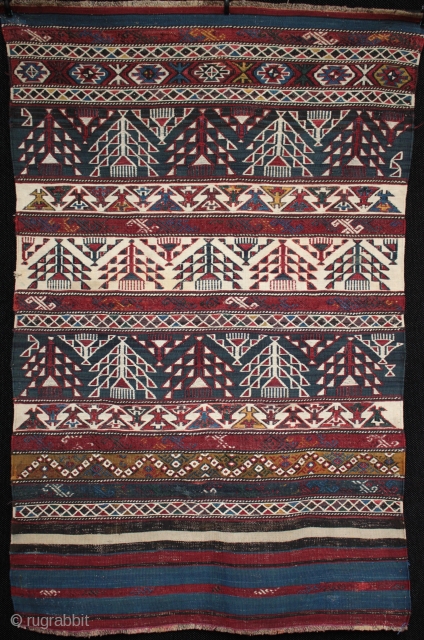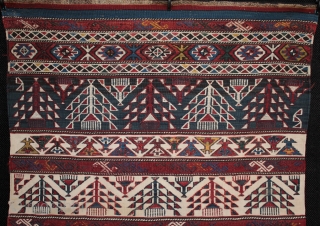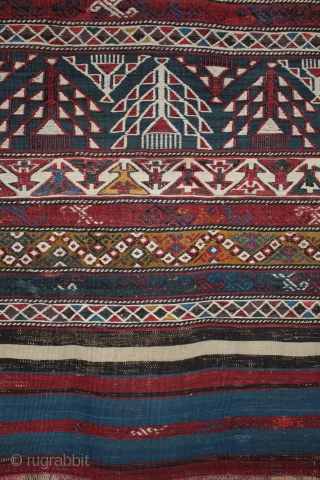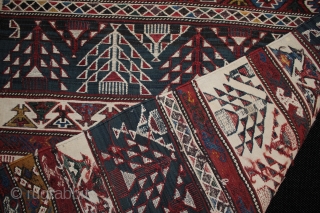Only one example of a complete camel cover of the same type with these tree of life motifs is known, published in Robert n. Nooter, ‘Rugs and Textiles from the Caucasus’, Atglen pa (2004). There is also a comparable example of a contemporary camel cover in the Azerbaijan National Museum, Carpets and Applied Art in Baku, museum inventory no. 1591, published by Museum Director Roya Tagieva in Azerbaijan Carpets (1999) Plate 293 (Зили. Ширванская группа. Азербайджан. Начало xx в. Государственный музей азербайджанского ковра. Баку).
Excellent intense colours from natural dyes with white cotton used in the flatweave and for the white parts of the soumac decoration. From the second half of the 19th century, perhaps the last quarter. Wool and white cotton on a warp of natural dark brown and ivory twisted sheep wool, a characeteristic of Khizi weavings. In very good condition with some old repairs, light corrosion to the black and some worn zili embroidered motifs, particularly across the lower striped kilim section which would have been over the back of the camel and most subject to wear. Size 120cm x 78cm.
My thanks to Michael b., Peter w., Simon g., Bertram f., Matthias w., and Vügar d. all of whom helped to establish the origin and provide references for this obscure and interesting weaving.
For detailed photos and details of the references provided above, see: http://www.kilim.ie/ANTIQUE_KILIMS/Pages/19th_c_Azeri_camel_cover_120x78...
Please contact me for more information.
- Home
- Antique Rugs by Region
- Category
- Profiles
- Post Items Free
- Albums
- Benaki Museum of Islamic Art
- Budapest: Ottoman Carpets
- Gulbenkian Museum
- Islamic Carpets. Brooklyn
- Islamic Textiles. Brooklyn
- Konya Museum: Rugs
- MKG, Hamburg
- MMA: Caucasian Carpets
- MMA: Mamluk Carpets
- MMA: Mughal Indian Carpets
- MMA: Ottoman Carpets
- MMA: Safavid Persian Carpets
- MMA: Turkmen Rugs
- McCoy Jones Kilims
- Ottoman textiles. Met
- Philadelphia Museum
- Rugs and Carpets: Berlin
- Seljuqs at the Met
- TIEM, Istanbul: Carpets
- V&A: Classical Carpets
- Vakiflar Carpets: Istanbul
- Baluch Rugs: Indianapolis
- Gallery Exhibitions
- Jaf an Exhibition
- Alberto Levi Gallery
- Andean Textile
- Christie's London: 2016
- Francesca Galloway
- HALI at 40
- ICOC Washington, DC 2018
- Jajims of the Shahsavan
- London Islamic Week April, 2018
- Mongolian Felts
- Navajo Rugs: JB Moore
- Persian Piled Weavings
- SF Tribal & Textile Art Show 2020
- SF Tribal 2019
- Sotheby's: C. Alexander
- Turkish Prayer Rugs
- Turkmen Main Carpets ICOC 2007











